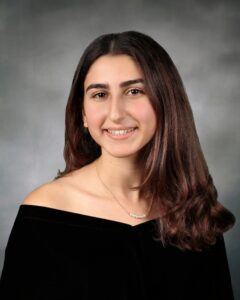Posted on April 5, 2022 in ASRC News, Neuroscience Initiative

On the strength of a prize-winning piece in The New York Times, Aliya Fisher was invited to assist with research at the Advanced Science Research Center, where she made a discovery related to the body’s internal timekeeping mechanisms.
For Bronx High School of Science student Aliya Fisher, achieving success in the 2020 New York Times STEM writing contest led to a timely connection. Fisher’s winning essay, which explains the body’s circadian clock through the metaphor of a symphony conductor, garnered the then-sophomore some high-level attention. Not long after it popped up on the Times’ Twitter feed, a comment appeared beneath it: “Very nice work, Aliya! There’s always a place for you in my lab working on the brain clock at the ASRC at CUNY if you’d like to do some research.”
The commenter, Professor Orie Shafer (Biology), runs the Shafer Lab within the Neuroscience Initiative at the Advanced Science Research Center at the CUNY Graduate Center (CUNY ASRC). His team studies fruit flies to learn more about “how time is kept within the brain and how it is used to orchestrate daily and seasonal behavior.” Fisher had been looking for just such an opportunity. As part of her high school’s research program, she had already applied to numerous labs.
“In sophomore year,” she says, “you email all these researchers and ask if you can come work in their lab. It’s awkward and a lot of work, and you don’t get many responses.”
Suddenly, she was preparing to conduct research at the CUNY ASRC. Because of the pandemic, she started remotely, reading foundational studies in the field, discussing them in Zoom conversations with Shafer, and analyzing data provided to her by Postdoctoral Research Associate Abhilash Lakshman, who guided Fisher in much of her day-to-day work. When pandemic restrictions eased, she conducted experiments in the lab, measuring the influence of genes across generations of fruit flies by putting the flies into pipettes and monitoring their activity with beams of infrared light.
“Working with Aliya was great,” Lakshman says. “She’s very enthusiastic, very sharp, and she asks the right questions.”
Fisher’s research yielded the novel finding that paternal influence in the circadian rhythms of fruits flies is more pronounced than had been recorded previously. According to Shafer, such a discovery is likely to prompt more research.
“Circadian timekeeping rests at the heart of health and well-being,” Shafer says. “If you don’t know how something is built, you can’t fix it when it breaks. Discovering that there is an epigenetic inheritance from dad that somehow governs how the clock runs could be really important.”
Fisher’s research with Shafer and Lakshman earned her recognition as a Scholar in the prestigious Regeneron Science Talent Search 2022, the nation’s oldest science and math competition for high school seniors and fueled her passion for scientific investigation.
“The whole idea of starting to do research in high school,” Fisher says, “is just an amazing thing. I never thought that I’d be able to do that. I hope that more high schoolers are able to have the same opportunity — to actually work in a lab and get to discover science before they go to college.”
Such experiences are of a piece, Shafer notes, with the Graduate Center’s broader mission.
“CUNY does an amazing job with economic mobility,” he says. “I really feel like this should be a gateway to anything anybody in New York wants to do, and that that should include STEM research and a Ph.D.”
Published by the Office of Communications and Marketing
